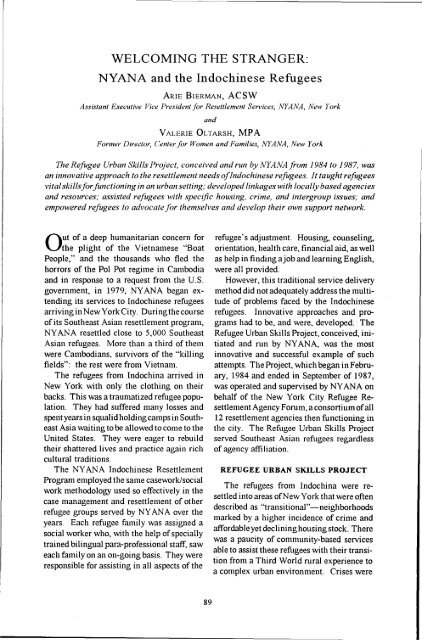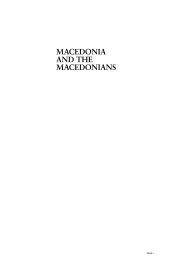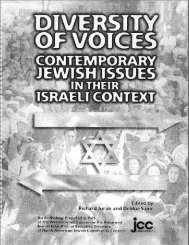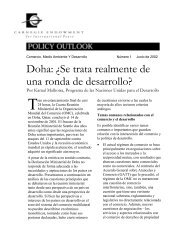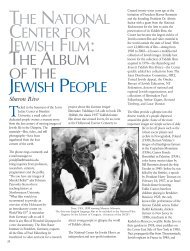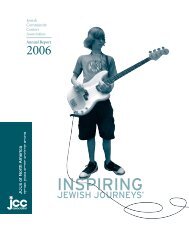WELCOMING THE STRANGER: NYANA and the Indochinese ...
WELCOMING THE STRANGER: NYANA and the Indochinese ...
WELCOMING THE STRANGER: NYANA and the Indochinese ...
Create successful ePaper yourself
Turn your PDF publications into a flip-book with our unique Google optimized e-Paper software.
<strong>WELCOMING</strong> <strong>THE</strong> <strong>STRANGER</strong>:<br />
<strong>NYANA</strong> <strong>and</strong> <strong>the</strong> <strong>Indochinese</strong> Refugees<br />
ARIE BIERMAN, ACSW<br />
Assistant Executive Vice President for Resettlement Services, <strong>NYANA</strong>, New York<br />
<strong>and</strong><br />
VALERIE OLTARSH, MPA<br />
Former Director, Center for Women <strong>and</strong> Families, <strong>NYANA</strong>, New York<br />
The Refugee Urban Skills Project, conceived <strong>and</strong>run by <strong>NYANA</strong> from 1984 to 1987, was<br />
an innovative approach to <strong>the</strong> resettlement needs of <strong>Indochinese</strong> refugees. It taught refugees<br />
vital skills for functioning in an urban .setting; developed linkages with locally ba.sed agencies<br />
<strong>and</strong> resources; assisted refugees with .specific housing, crime, <strong>and</strong> intergroup issues; <strong>and</strong><br />
empowered refugees to advocate for <strong>the</strong>mselves <strong>and</strong> develop <strong>the</strong>ir own support network.<br />
Out of a deep humanitarian concern for<br />
<strong>the</strong> pHght of <strong>the</strong> Vietnamese "Boat<br />
People," <strong>and</strong> <strong>the</strong> thous<strong>and</strong>s who fled <strong>the</strong><br />
horrors of <strong>the</strong> Pol Pot regime in Cambodia<br />
<strong>and</strong> in response to a request from <strong>the</strong> U.S.<br />
government, in 1979, <strong>NYANA</strong> began ex<br />
tending its services to <strong>Indochinese</strong> refugees<br />
arriving in New York City. During<strong>the</strong> course<br />
of its Sou<strong>the</strong>ast Asian resettlement program,<br />
<strong>NYANA</strong> resettled close to 5,000 Sou<strong>the</strong>ast<br />
Asian refugees. More than a third of <strong>the</strong>m<br />
were Cambodians, survivors of <strong>the</strong> "killing<br />
fields": <strong>the</strong> rest were from Vietnam.<br />
The refugees from Indochina arrived in<br />
New York with only <strong>the</strong> clothing on <strong>the</strong>ir<br />
backs. This was a traumatized refugee popu<br />
lation. They had suffered many losses <strong>and</strong><br />
spent years in squalid holding camps in South<br />
east Asia waiting to be allowed to come to <strong>the</strong><br />
United States. They were eager to rebuild<br />
<strong>the</strong>ir shattered lives <strong>and</strong> practice again rich<br />
cultural traditions.<br />
The <strong>NYANA</strong> <strong>Indochinese</strong> Resettlement<br />
Program employed <strong>the</strong> same casework/social<br />
work methodology used so effectively in <strong>the</strong><br />
case management <strong>and</strong> resettlement of o<strong>the</strong>r<br />
refugee groups served by <strong>NYANA</strong> over <strong>the</strong><br />
years. Each refugee family was assigned a<br />
social worker who, with <strong>the</strong> help of specially<br />
trained bilingual para-professional staff, saw<br />
each family on an on-going basis. They were<br />
responsible for assisting in all aspects of <strong>the</strong><br />
89<br />
refugee's adjustment. Housing, counseling,<br />
orientation, health care, fmancial aid, as well<br />
as help in finding ajob <strong>and</strong> learning English,<br />
were all provided.<br />
However, this traditional service delivery<br />
method did not adequately address <strong>the</strong> multi<br />
tude of problems faced by <strong>the</strong> <strong>Indochinese</strong><br />
refugees. Innovative approaches <strong>and</strong> pro<br />
grams had to be, <strong>and</strong> were, developed. The<br />
Refugee Urban Skills Project, conceived, ini<br />
tiated <strong>and</strong> run by <strong>NYANA</strong>, was <strong>the</strong> most<br />
innovative <strong>and</strong> successful example of such<br />
attempts. TheProject, whichbegan in Febru<br />
ary, 1984 <strong>and</strong> ended in September of 1987,<br />
was operated <strong>and</strong> supervised by <strong>NYANA</strong> on<br />
behalf of <strong>the</strong> New York City Refugee Re<br />
settlement Agency Forum, a consortium of all<br />
12 resettlement agencies <strong>the</strong>n functioning in<br />
<strong>the</strong> city. The Refugee Urban Skills Project<br />
served Sou<strong>the</strong>ast Asian refugees regardless<br />
of agency affiliation.<br />
REFUGEE URBAN SKILLS PROJECT<br />
The refugees from Indochina were re<br />
settled into areas of New York that were often<br />
described as "transitional"—neighborhoods<br />
marked by a higher incidence of crime <strong>and</strong><br />
affordable yet declining housing stock. There<br />
was a paucity of community-based services<br />
able to assist <strong>the</strong>se refugees with <strong>the</strong>ir transi<br />
tion from a Third World rural experience to<br />
a complex urban environment. Crises were
erupting. The absence of heat <strong>and</strong> hot water<br />
as well as o<strong>the</strong>r housing-related issues threat<br />
ened <strong>the</strong> health of <strong>the</strong> refugees. Inter-group<br />
<strong>and</strong> inter-racial stresses flared up. Local<br />
agencies felt frustrated at being unable to<br />
cope with <strong>the</strong>se newest members of <strong>the</strong>ir<br />
communities—refiigees whose language, cul<br />
ture, <strong>and</strong> life experience seemed so alien.<br />
The Refugee Urban Skills Project grew out<br />
of a <strong>NYANA</strong>-based graduate social work<br />
student project. In 1983, two students, one<br />
from Fordham <strong>and</strong> <strong>the</strong> o<strong>the</strong>r from <strong>the</strong><br />
Wurzweiler School of Social Work at Ye<br />
shiva University, were sent into <strong>the</strong>se com<br />
munities to assess <strong>the</strong> needs <strong>and</strong> to start<br />
addressing some of <strong>the</strong>m. The students began<br />
forming refugee tenants groups, visiting lo<br />
cal agencies, <strong>and</strong> providing orientation to<br />
both refugees <strong>and</strong> local service providers<br />
such as clinics <strong>and</strong> schools. The student<br />
effort highlighted <strong>the</strong> urgent needs <strong>and</strong> also<br />
provided a viable <strong>and</strong> effective model for<br />
meeting <strong>the</strong>m.<br />
With grants from <strong>the</strong> Ford Foundation,<br />
Exxon Corporation, <strong>and</strong> <strong>the</strong> Lebrun Founda<br />
tion as well as fiinds from <strong>the</strong> New York State<br />
Refugee Program, <strong>the</strong> Refiigee Urban Skills<br />
Project formally began in February of 1984,<br />
Under <strong>the</strong> supervision of one of <strong>the</strong> recently<br />
graduated students involved with <strong>the</strong> project<br />
from <strong>the</strong> beginning, service teams were formed<br />
<strong>and</strong> trained to work in high-density refiigee<br />
communities. Operating in <strong>the</strong> Bronx <strong>and</strong><br />
Brooklyn, <strong>the</strong> two boroughs of New York City<br />
where <strong>Indochinese</strong> refugees were resettled in<br />
large numbers, <strong>the</strong>se teams had four goals;<br />
1, teach refugees vital survival skills for<br />
fiinctioning in a complex urban setting<br />
2, help develop linkages <strong>and</strong> relationships<br />
with a host of locally based agencies <strong>and</strong><br />
resources<br />
3, assist refugees with specific housing,<br />
crime, intergroup, <strong>and</strong> educational prob<br />
lems<br />
4, empower refugees to advocate for <strong>the</strong>m<br />
selves <strong>and</strong> develop communal <strong>and</strong> insti<br />
tutional supports<br />
Journal of Jewish Communal Service / 90<br />
FALL 1998<br />
The typical Urban Skills team, of which<br />
<strong>the</strong>re were three, comprised a master's-level<br />
social worker <strong>and</strong> a bilingual paraprofes-<br />
sional aide. These community aides were<br />
<strong>the</strong>mselves refugees who were intimately<br />
aware of <strong>the</strong> problems <strong>and</strong> concerns of <strong>the</strong>ir<br />
communities <strong>and</strong> lived in <strong>the</strong> very same ar<br />
eas. The Project's basic approach stressed <strong>the</strong><br />
need for staff to be out in <strong>the</strong> community, in<br />
<strong>the</strong> refugee apartments <strong>and</strong> neighborhoods.<br />
Using <strong>the</strong> group work modality, <strong>the</strong>se teams<br />
worked in apartment buildings with a signifi<br />
cant refiigee clientele.<br />
The Refiigee Urban Skills Project was<br />
active in more than 40 buildings in both <strong>the</strong><br />
Bronx <strong>and</strong> Brooklyn with a combined ten<br />
ancy, refiigee, <strong>and</strong> non-refugee, of approxi<br />
mately 12,000 people. In every building<br />
where <strong>the</strong> Urban Skills teams worked, <strong>the</strong><br />
improvements in basic services affected all of<br />
<strong>the</strong> residents. Part of <strong>the</strong> project's philosophy<br />
was that all of <strong>the</strong> building's tenants, whe<strong>the</strong>r<br />
native- or foreign-born, were invited to join<br />
<strong>the</strong> project's tenant-based building improve<br />
ment teams. The refiigee tenant groups orga<br />
nized by <strong>the</strong> Project were viewed as effective<br />
instruments by <strong>the</strong>ir non-refiigee neighbors.<br />
For example, in one apartment building in<br />
<strong>the</strong> Fordham area of <strong>the</strong> Bronx, "We didn't<br />
know howto get along in this city <strong>and</strong> couldn't<br />
talk to anybody except o<strong>the</strong>r Vietnamese,"<br />
recalled Tran N. who lived in that apartment<br />
building. Although rents were low, <strong>the</strong>re<br />
were serious heat <strong>and</strong> hot water problems,<br />
bursting pipes, <strong>and</strong> a leaking roof <strong>and</strong> win<br />
dows. Much of what once was inhospitable<br />
improved with <strong>the</strong> help of <strong>the</strong> Urban Skills<br />
team who formed a tenants association that<br />
included many American tenants. This join<br />
ing toge<strong>the</strong>r of forces—putting all rent fiinds<br />
into an escrow account <strong>and</strong> learning o<strong>the</strong>r<br />
empowering <strong>and</strong> advocacy techniques—was<br />
instrumental in obtaining improvements in<br />
<strong>the</strong> building <strong>and</strong> in building positive relation<br />
ships with neighbors. Within a year of <strong>the</strong><br />
tenants association's formation, significant<br />
repairs were done in <strong>the</strong> building.
The Refugee Urban Skills Project also<br />
worked with over 45 locally based commu<br />
nity groups <strong>and</strong> agencies. The Project helped<br />
to ease some of <strong>the</strong> enoritious pressures <strong>the</strong>se<br />
agencies faced, alleviating <strong>the</strong> huge caseload<br />
<strong>and</strong> burdens with which <strong>the</strong>y coped. It be<br />
came an active partner in <strong>the</strong>se agencies'<br />
efforts at neighborhood stabilization, at stem<br />
ming <strong>the</strong> decline of services, <strong>and</strong> in prevent<br />
ing <strong>the</strong> fur<strong>the</strong>r deterioration of housing.<br />
In one example of community-based in<br />
volvement, after a series of break-ins at an<br />
apartment building in Brooklyn, <strong>the</strong> Refiigee<br />
Urban Skills team served as a liaison with <strong>the</strong><br />
local police precinct. As a result of <strong>the</strong>ir<br />
efforts, a community affairs officer came <strong>and</strong><br />
met with <strong>the</strong> refugee tenants group. The<br />
<strong>Indochinese</strong> refugees had many fears of po<br />
lice based on experiences in <strong>the</strong>ir Communist<br />
homel<strong>and</strong>s. Similarly, <strong>the</strong> local precinct<br />
comm<strong>and</strong>er in Brooklyn was at a loss on how<br />
to reach out to <strong>the</strong>se newest residents. He<br />
knew <strong>the</strong>y were being victimized, but <strong>the</strong>y<br />
were reluctant to seek police help. The lan<br />
guage <strong>and</strong> cultural barriers seemed over<br />
whelming. The tenants group meeting with<br />
a police official became one in a series in<br />
which <strong>the</strong> Urban Skills staff served as trans<br />
lators as well as facilitators. The sessions<br />
with <strong>the</strong> tenants resulted in increased patrols<br />
<strong>and</strong> monitoring of that particular building,<br />
created a better underst<strong>and</strong>ing of American<br />
law enforcement by <strong>the</strong> refiigees, <strong>and</strong> gave <strong>the</strong><br />
police a less stereotypical view of Asian refu<br />
gees, <strong>the</strong>ir culture, <strong>and</strong> needs.<br />
Ano<strong>the</strong>r role of <strong>the</strong> Refugee Urban Skills<br />
Project was to act as cultural intermediary<br />
between <strong>Indochinese</strong> refugees <strong>and</strong>local health<br />
care providers. Culture plays such a critical<br />
role in apatient's interpretation of illness <strong>and</strong><br />
healing; health care providers need to under<br />
st<strong>and</strong> what <strong>the</strong>ir patients see as <strong>the</strong> causes of<br />
illness, how a malady was h<strong>and</strong>led in <strong>the</strong>ir<br />
more traditional society <strong>and</strong> home country,<br />
who traditionally treated disease, <strong>and</strong> how<br />
certain beliefs, such as <strong>the</strong> body's balance<br />
between hot <strong>and</strong> cold, would affect <strong>the</strong>ir<br />
reactions to diagnostic <strong>and</strong> treatment proce<br />
dures routinely performed in <strong>the</strong> United States.<br />
<strong>NYANA</strong> <strong>and</strong> <strong>the</strong> <strong>Indochinese</strong> Refugees / 91<br />
FALL 1998<br />
Consider this case illustration.<br />
Mr. K from Cambodia had been in <strong>the</strong> United<br />
States for seven months when he went to a<br />
local Bronx health chnic. He was expetienc<br />
ing nightmares <strong>and</strong> a severe cough with flu<br />
like symptoms. The Urban Skills Project<br />
helped <strong>the</strong> American doctor underst<strong>and</strong> <strong>the</strong><br />
Cambodian patient's reluctance to have blood<br />
drawn. The drawing of blood was viewed by<br />
<strong>the</strong> refugee as a draining of <strong>the</strong> spirit, of his<br />
lifeforce, <strong>and</strong> was thus somethingto be avoided.<br />
Similarly, Mr. K felt it was not necessary to<br />
take <strong>the</strong> full course of antibiotics because <strong>the</strong><br />
pills were meant for Americans who were<br />
physically much bigger than Asians <strong>and</strong> <strong>the</strong>re<br />
fore he, as an Asian, needed fewer piUs. With<br />
Urban Skills staff help <strong>the</strong> clinic doctor was<br />
able to commuiucate to Mr. K a respect for,<br />
<strong>and</strong> an underst<strong>and</strong>ing of Cambodian tradi<br />
tional health behefs. The Cambodian's com<br />
pliance with medical treatment improved<br />
through <strong>the</strong> use of a bi-cultural, bilingual<br />
interpreter, by mini mi Ting testing procedures,<br />
<strong>and</strong> by explaining in detail <strong>the</strong> rationale for <strong>the</strong><br />
medication prescription.<br />
The Project averted inter-group <strong>and</strong> inter<br />
racial conflict, <strong>the</strong>reby easing stresses in <strong>the</strong><br />
community. In one such example, <strong>the</strong> Urban<br />
Skills staff had formed a tenants group in a<br />
building in <strong>the</strong> Allerton area of <strong>the</strong> Bronx.<br />
They tried to encourage non-refugee tenants<br />
to join, but were meeting resistance. Finally,<br />
several of <strong>the</strong> African-American residents<br />
agreed to attend a meeting. The Urban Skills<br />
team sensed some tension in <strong>the</strong> room <strong>and</strong><br />
encouraged an open discussion. After some<br />
awkwardness <strong>and</strong> hesitancy, one of <strong>the</strong> non-<br />
refugees opened up <strong>and</strong> said that she was<br />
angry that <strong>the</strong> refugees were getting special<br />
treatment from <strong>the</strong> government. When asked<br />
what she meant, <strong>the</strong> women said she <strong>and</strong><br />
o<strong>the</strong>rs have seen trucks come to <strong>the</strong> building<br />
delivering large sacks of free rice to <strong>the</strong><br />
refugees <strong>and</strong> how unfair it was for <strong>the</strong> govern<br />
ment to do this; <strong>the</strong> Americans deserved rice<br />
too. The refugees <strong>the</strong>n explained that <strong>the</strong>se<br />
were not government trucks, but ra<strong>the</strong>r were
from stores in Cliinatown. The refugees<br />
bought rice in bulk at a savings, <strong>and</strong> <strong>the</strong> stores<br />
offered free delivery in order to keep <strong>the</strong>m as<br />
customers. The tension eased, especially<br />
when <strong>the</strong> non-refugees were invited to pur<br />
chase rice with <strong>the</strong> refugees at a discount<br />
using <strong>the</strong> same stores <strong>and</strong> truck service deliv<br />
ery. It was instructive for all to have experi<br />
enced how a minor misunderst<strong>and</strong>ing created<br />
tensions <strong>and</strong> fed into negative perceptions.<br />
Once <strong>the</strong> rice incident was resolved, <strong>the</strong> group<br />
was forced to tackle o<strong>the</strong>r common issues<br />
faced by refugees <strong>and</strong> non-refiigees. The<br />
African-American tenants became regular<br />
participants in <strong>the</strong> tenants association meet<br />
ings.<br />
The Refugee Urban Skills Project was<br />
instrumental in estabhshing community-based<br />
coordinating mechanisms such as <strong>the</strong> Bronx<br />
Alliance for Refiigee Services (BARS), which<br />
was operational for seven years. That coali<br />
tion of community organizations rapidly<br />
evolved into an effective clearinghouse of<br />
information, an advocate for services, <strong>and</strong> a<br />
coordinating body on service issues. Issues of<br />
turf were minimized, <strong>and</strong> agencies, instead of<br />
blaming one ano<strong>the</strong>r for problems <strong>and</strong> gaps<br />
in service, found common cause in finding<br />
solutions.<br />
Ano<strong>the</strong>r important achievement of <strong>the</strong><br />
Urban Skills Project was <strong>the</strong> key role it played<br />
Journal of Jewish Communal Service / 92<br />
in helping <strong>the</strong> Bronx Cambodian refugee<br />
community purchase a building to serve as a<br />
Buddhist temple. Buddhism <strong>and</strong> particularly<br />
<strong>the</strong> Buddhist temple played a central role in<br />
Cambodian culture, serving as a source of<br />
spiritual <strong>and</strong> communal strength <strong>and</strong> stabil<br />
ity. The establishment of a temple in <strong>the</strong><br />
Bronx <strong>and</strong> one later in Brooklyn was a no<br />
table undertaking <strong>and</strong> remains to this day a<br />
symbol of <strong>the</strong> unique role <strong>NYANA</strong> played via<br />
<strong>the</strong> Refugee Urban Skills Project in helping<br />
<strong>the</strong> refugees from Sou<strong>the</strong>ast Asia.<br />
As planned from <strong>the</strong> outset, <strong>the</strong> Refugee<br />
Urban Skills Project ended in September of<br />
1987 after three <strong>and</strong> a half years of service.<br />
<strong>NYANA</strong>, which originated <strong>and</strong> ran <strong>the</strong> project,<br />
provided invaluable help to hard-pressed com<br />
munities in New York, to refugees <strong>and</strong> non-<br />
refugees. The Project's goals of educating<br />
<strong>and</strong> empowering refugees <strong>and</strong> <strong>the</strong>ir neigh<br />
borhoods to better help <strong>the</strong>mselves had been<br />
met. <strong>Indochinese</strong> refugees often expressed<br />
<strong>the</strong>ir appreciation to <strong>NYANA</strong> <strong>and</strong> <strong>the</strong> Jewish<br />
community <strong>and</strong> wondered why <strong>NYANA</strong><br />
seemed so unique <strong>and</strong> special. The response<br />
was a natural one. We, <strong>the</strong> Jewish people<br />
knew all too well what it was like to be<br />
persecuted, to be refugees, to be <strong>the</strong> stranger.<br />
Our history, <strong>and</strong> our tradition of helping <strong>the</strong><br />
stranger is a long <strong>and</strong> proud one to which<br />
<strong>NYANA</strong> added a small yet meaningful chap<br />
ter.<br />
FALL 1998


